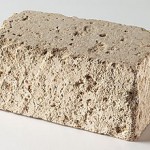
Researchers have succeeded with a new method for purifying biogas through the use of natural zeolites from tuff waste. Scientists at the Institute of Atmospheric Pollution Research of the Italian Research Council conducted experiments into adsorption and desorption rates in order to determine if it is feasible to filter biogas through zeolites to produce biomethane.
The fermentation of biomass to produce biogas is undoubtedly an important field of study, since it reduces harmful emissions created from fossil fuel consumption and therefore decreases the greenhouse effect. The upgrading of biogas to biomethane can further reduce environmental impact as well as producing a clean and renewable fuel. In order to make this possible, researchers investigated the use of natural zeolites from tuff waste as a means of adsorbing carbon dioxide and harmful compounds.
Zeolites can be a realistic alternative for biogas upgrading
The purification of biogas requires the removal or reduction of secondary components. Perhaps the most important of these is hydrogen sulphide due to its toxic properties, noxious smell and capability of damaging plants or pipes. Other components to be removed include water and siloxanes, both of which reduce the calorific value of biomethane, while the latter is also highly toxic and damaging. The upgrading of biogas, or the removal of carbon dioxide, gives a higher calorific value to the fuel. While processes for the removal of these components currently exist, they all have major disadvantages that render them rather expensive and sometimes unfeasible for large-scale production. Zeolites on the other hand, known for their adsorption properties, can offer a more realistic alternative.
Researchers tested adsorption rates by passing carbon dioxide, hydrogen sulphide and methane separately through a layer of zeolites within a cylindrical cartridge and measuring the concentration of the remaining gas downstream. To confirm results, the weight of the zeolites was measured before and after experimentation. Variables included grain size and linear velocity. For carbon dioxide, zeolites were shown to adsorb 6g of carbon dioxide per 100g of tuff at atmospheric pressure, removing up to 99.5% carbon dioxide. Hydrogen sulphide adsorption was equally successful with a 99% efficiency or 4g per 100g of tuff, though the breakthrough volume was smaller. Hydrogen sulphide and carbon dioxide were then passed through zeolites together, which confirmed the competition that exists between the two: on the surface of zeolites, both gases are adsorbed on the same sites. Methane was also passed through to ensure that no interaction takes place between it and the natural zeolites.
High purity biomethane and effective regeneration of zeolites
There are a great number of interferents such as dust particles, ammonia and humidity present in real biogas, which were expected to provide competitive adsorption and drastically reduce the upgrading efficiency and capacity of the zeolites. However, following the same processes described above, the natural biogas interferents present were shown to not significantly affect the process, and a high purity biomethane was produced.
Regeneration properties of the zeolites, vital for continuous use, were also studied under both heat and pressure. Thermal regeneration proved the most effective for both carbon dioxide and hydrogen sulphide after numerous adsorption/desorption cycles, with carbon dioxide being entirely removed after 125°C. Vacuum regeneration at both 300 mbar and 800 mbar was not as successful, only achieving 95% carbon dioxide desorption, though this is nonetheless a result worth further investigation.
These experiments have shown that zeolites are a very real and viable option for purifying and upgrading biogas into a more efficient fuel. They are low cost, in plentiful supply, stable and fully regenerable through several adsorption/desorption cycles. This process can therefore be highly lucrative and sustainable, which is required for a biogas upgrading plant.
This post is based on an paper presented at the 22nd EUBCE and written by Valerio Paolini et al. The full paper and slides are published in the conference proceedings and can be downloaded at the link below.


